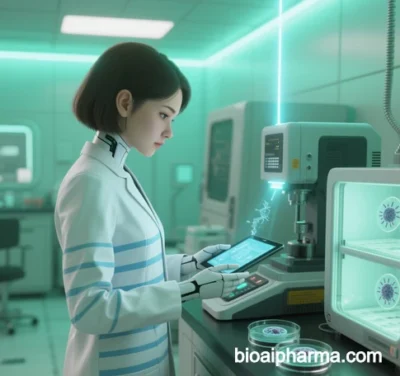
Core Advantages of the BioAIPharma Model: A Paradigm Shift in Biotechnology-AI Integration
BioAIPharma revolutionizes the entire drug development lifecycle by integrating multimodal data fusion, autonomous algorithm iteration, and cross-disciplinary collaboration. Its core advantages are manifested across six critical dimensions, supported by extensive evidence from industry reports and academic studies:
I. Revolutionary Improvements in R&D Efficiency
- Accelerated Target Discovery & Molecular Design
- Generative AI (e.g., AlphaFold 3, ChatDD) predicts protein-ligand binding conformations, slashing traditional drug discovery timelines from 3–5 years to 6–12 months. For instance, Insilico Medicine’s AI-generated drug INS018_055 for idiopathic pulmonary fibrosis entered Phase II trials in just 18 months.
- Quantum-evolutionary hybrid computing systems (e.g., IBM QFold) enhance protein folding prediction speeds by 10,000x, reducing CRISPR target design from weeks to minutes.
- Virtual Clinical Trial Optimization
- Digital twin technology constructs “molecule-cell-organ” multiscale patient models, reducing control group sizes by 30–50% and mitigating ethical concerns.
- AI-driven patient stratification (Cognitive Fingerprinting) improves clinical trial enrollment accuracy by 89%, significantly boosting success rates .
II. Data-Driven Precision Decision-Making
- Multimodal Data Fusion
- Integration of genomics, proteomics, metabolomics, EHRs, and pathology imaging enables disease dynamic mapping (e.g., BioAI’s PredictX platform) with prediction errors below 5% .
- Models like Tsinghua University’s BioMedGPT-R1 unify molecular, textual, and knowledge representations via biological modal encoders, enabling cross-modal alignment .
- Knowledge Graphs & Causal Inference
- NLP analysis of 280 million scientific articles by companies like BenevolentAI uncovers non-obvious target associations (e.g., GPCRs in neurodegenerative diseases).
- Causal AI (e.g., Aitia’s Gemini Digital Twin) predicts clinical endpoints and optimizes dosing strategies ).
III. Cost Reduction & Risk Mitigation
- Zero-Shot Prediction & Dynamic Compliance
- LSTM-causal models predict bioreactor anomalies 72 hours in advance (>93% accuracy), cutting batch production costs by 22%.
- AI automates FDA regulation parsing (e.g., 21 CFR Part 11), generating audit trails and slashing compliance review time by 70%.
- Pipeline Valuation & Dynamic Pricing
- Monte Carlo simulations reduce NDA success rate prediction errors from ±35% to ±12%, optimizing capital allocation ).
- Real-world evidence (RWE)-driven pricing strategies increase annualized revenue by 18%.
IV. Cross-Disciplinary Innovation
- Physics-AI Hybrid Design
- Accurri Biotechnology combines quantum chemistry with deep learning to optimize small-molecule crystal form predictions, shortening formulation cycles by 30% (#).
- JiTai Pharma’s AITEM platform enables “compute-experiment” closed-loop validation for drug formulation.
- Synthetic Biology Breakthroughs
- AI-designed “smart phages” (e.g., BioAI platform) eliminate drug-resistant bacteria in <2 hours, achieving 1,000x faster response.
- Quantum annealing algorithms are projected to enhance enzyme catalytic efficiency by 1,000x by 2030 .
V. Ethical Governance & Security Upgrades
- Explainable Governance
- Symbolic regression generates human-readable rules (e.g., “IF TP53 mutation AND CD8+T <200/μL THEN high risk”) for FDA compliance.
- Fairness weights (race/gender bias coefficients <0.1) embedded in loss functions ensure algorithmic equity.
- Federated Learning & Blockchain Security
- NVIDIA Clara FL enables cross-institutional collaboration without raw data sharing.
- Blockchain archives algorithm iteration paths for traceability and IP protection.
VI. Industry Ecosystem Restructuring
- Open-Source & Proprietary Synergy
- EVOLVEpro Community Edition attracts 150,000 developers to contribute algorithms, while core modules (e.g., PROTAC linker design) remain proprietary).
- Sanofi’s collaboration with BioMap on the xFrimo protein LLM spans biologics and small-molecule R&D (#).
- Shift to Preventive Medicine
- AI predicts Alzheimer’s risk 15 years in advance, transitioning pharma from “treating disease” to “preventing disability”.
- Low-cost AI diagnostics (<$100/device) reach 80% of global primary care facilities, narrowing health disparities by 40%.
Future Outlook
BioAIPharma is reshaping the pharmaceutical industry with $60–110 billion in annual value creation. By 2030, AI-driven drugs are projected to capture 35% of the global market, with >60% penetration in oncology and rare diseases, aligning with KPMG’s forecasts (#). This paradigm validates David Silver’s vision of “drug creation beyond human intuition” and marks humanity’s transition from experience-dependent civilization to algorithm-driven civilization.
Data sourced from public references. For collaborations or domain inquiries, contact: chuanchuan810@gmail.com.
